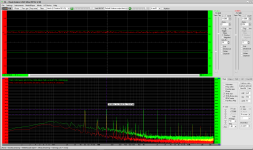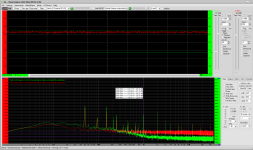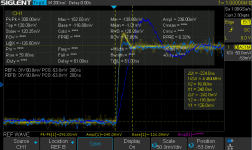Hi all,
I finally had the chance to evaluate the NJM8830 and compare it with some well-established operational amplifiers like the OPA1612A and OPA1642A, which have long been considered golden standards in the audio domain for their performance and cost-effectiveness—covering both bipolar and FET input segments.
The NJM8830 is a compact, rail-to-rail output op-amp designed to operate from 4V to 10.5V (±2.0 to ±5.25 ), delivering up to 100mA (150mA max) of output current even at low impedances. It boasts impressive specifications for its class, including an ultra-low THD+N of 0.000012% at 3.3V, an input voltage noise density of just 2.5nV/√Hz @1kHz, a wide gain-bandwidth product of 90MHz, and a slew rate of 30V/µs.
I received the NJM8830 some time ago, but due to intense research obligations, my audio hobby had been sidelined for the past two years. For this test, I configured a two-stage +37 dB preamp (using both op-amps from the same IC in series for a single channel), terminated with 50 ohms at the input, to accurately measure the amplifier's intrinsic noise floor.
Other op-amps such as the NE5532A, LM4562NA, and the OPA1652/1656/1662 series performed notably worse in this context, so I chose not to include them in this comparison.
What stands out immediately is that the NJM8830 clearly outperforms the OPA1642A across the entire range, although it does not ultimately surpass the OPA1612A—which, to be fair, was expected.
NJM8830 is represented with a green trace, while OPA1612A and OPA1642A are shown in red.
p.s. In a separate test focusing on transient response and settling time, I applied a 40 mV(p-p) square wave (@1kHz, Tr/Tf <10ns) input with a single-stage, 13 dB gain configuration (one op-amp per channel). The NJM8830 demonstrated comparable rise and fall times but showed significantly reduced overshoot and faster stabilization. This implies lower ringing, suggesting that its internal design provides tangible improvements in responsiveness and stability over previous generation devices.
Additionally, to better illustrate this, here is an oscilloscope capture showing the response to a 50 mV input signal. The light blue trace represents the recorded output of the NJM8830, the dark blue trace corresponds to a previous capture from the OPA1642A, while the yellow “live” trace shows the performance of the OPA1612A in real-time.
Best regards,
Dr. Jovan Ivković
I finally had the chance to evaluate the NJM8830 and compare it with some well-established operational amplifiers like the OPA1612A and OPA1642A, which have long been considered golden standards in the audio domain for their performance and cost-effectiveness—covering both bipolar and FET input segments.
The NJM8830 is a compact, rail-to-rail output op-amp designed to operate from 4V to 10.5V (±2.0 to ±5.25 ), delivering up to 100mA (150mA max) of output current even at low impedances. It boasts impressive specifications for its class, including an ultra-low THD+N of 0.000012% at 3.3V, an input voltage noise density of just 2.5nV/√Hz @1kHz, a wide gain-bandwidth product of 90MHz, and a slew rate of 30V/µs.
I received the NJM8830 some time ago, but due to intense research obligations, my audio hobby had been sidelined for the past two years. For this test, I configured a two-stage +37 dB preamp (using both op-amps from the same IC in series for a single channel), terminated with 50 ohms at the input, to accurately measure the amplifier's intrinsic noise floor.
Other op-amps such as the NE5532A, LM4562NA, and the OPA1652/1656/1662 series performed notably worse in this context, so I chose not to include them in this comparison.
What stands out immediately is that the NJM8830 clearly outperforms the OPA1642A across the entire range, although it does not ultimately surpass the OPA1612A—which, to be fair, was expected.
NJM8830 is represented with a green trace, while OPA1612A and OPA1642A are shown in red.
p.s. In a separate test focusing on transient response and settling time, I applied a 40 mV(p-p) square wave (@1kHz, Tr/Tf <10ns) input with a single-stage, 13 dB gain configuration (one op-amp per channel). The NJM8830 demonstrated comparable rise and fall times but showed significantly reduced overshoot and faster stabilization. This implies lower ringing, suggesting that its internal design provides tangible improvements in responsiveness and stability over previous generation devices.
Additionally, to better illustrate this, here is an oscilloscope capture showing the response to a 50 mV input signal. The light blue trace represents the recorded output of the NJM8830, the dark blue trace corresponds to a previous capture from the OPA1642A, while the yellow “live” trace shows the performance of the OPA1612A in real-time.
Best regards,
Dr. Jovan Ivković
Attachments
It would be a good thing to emphasise NJM8830 has maximum rail voltages of +/- 5.25V which reduces its versatility and it therefore belongs in a different category. It is not a direct replacement for the other types you mention as these are usually implemented with way higher (+/- 9...15V) rail voltages in the majority of cases. BTW were they all measured at +/- 5V?
NJM8830 is therefore probably no material for the average opamp roller (even though its performance seems excellent on paper).
NJM8830 is therefore probably no material for the average opamp roller (even though its performance seems excellent on paper).
Last edited:
I wonder what its equivalent input noise current with unequal impedances driving the inputs is. I don't see any information about equivalent input noise current in the datasheet.
The OPA1611 or OPA1612 is optimal; for higher current delivery, it's recommended to add a small Class A push-pull stage. I don't think the NJM8830 is as good.
I found the following op amp on Aliexpress that uses this hybrid principle. Don't worry, it's not fake and it works fantastically.
https://a.aliexpress.com/_EHgLhRc
I found the following op amp on Aliexpress that uses this hybrid principle. Don't worry, it's not fake and it works fantastically.
https://a.aliexpress.com/_EHgLhRc
NJM8830 can deliver up to 100 mA. Specifically one of its strongpoints.
Maybe it is a good idea to keep the thread focussed on NJM8830. Seems quite an achiever really, just with limited usability.
Maybe it is a good idea to keep the thread focussed on NJM8830. Seems quite an achiever really, just with limited usability.
Last edited:
..." this product adds 1 pair of NPN PNP complementary and symmetrical 500MA Philips low-noise tubes, which increase"... 🙂the following op amp on Aliexpress
//
Then I would rather use the chip from Ali-Express, which delivers 150mA in ClassANJM8830 can deliver up to 100 mA. Specifically one of its strongpoints.
Maybe it is a good idea to keep the thread focussed on NJM8830. Seems quite an achiever really, just with limited usability.
Not the thread subject, that is NJM8830 and its capabilities compared to other contemporary dual opamps.
Last edited:
This is not a general-purpose opamp. The distortion and output drive current are impressive, but the noise specs and supply current are nothing special. It would make a great IE or low-impedance headphone driver, but it would not be suitable for Hi-Z headphones. The high supply current (~6mA) means it is not really suitable for portable applications.
Moral of the story: you really have to fit the opamp to the job, and when it all boils down to it, there really isn't any such thing as a general purpise opamp - they have to chosen for the specific task at hand.
Moral of the story: you really have to fit the opamp to the job, and when it all boils down to it, there really isn't any such thing as a general purpise opamp - they have to chosen for the specific task at hand.
- Home
- Amplifiers
- Chip Amps
- NJM8830 – A New Challenger in the Hi-Fi Op-Amp Arena



